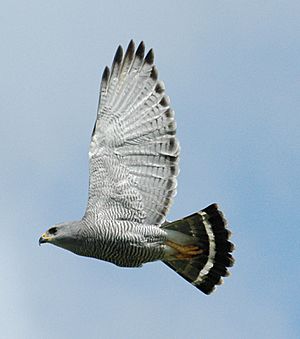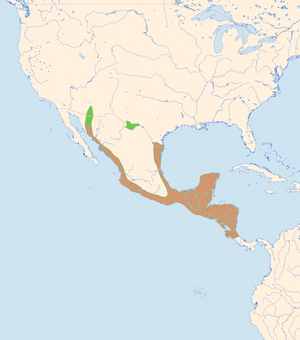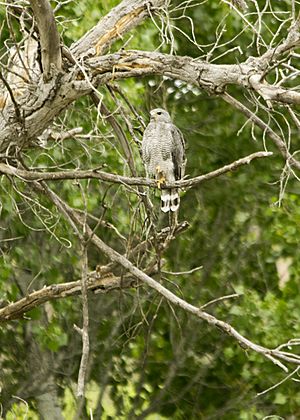Gray hawk facts for kids
Quick facts for kids Gray hawk |
|
|---|---|
 |
|
| Conservation status | |
| Scientific classification | |
| Genus: |
Buteo
|
| Species: |
plagiatus
|
 |
|
| Synonyms | |
|
Asturina plagiata |
|
The gray hawk (Buteo plagiatus) is a small bird of prey also known as the Mexican goshawk. You can find it in open areas and along the edges of forests. It lives from Costa Rica all the way north to the southwestern United States.
This hawk is about 46 to 61 centimeters (18 to 24 inches) long. It weighs around 475 grams (17 ounces). Adult gray hawks have a light gray body. Their tail is black with three white stripes, and their legs are orange. Their upper body is a solid, plain gray.
Young gray hawks look different. They have dark brown upper parts and a brown tail with light stripes. Their underside is white with brown spots. Their head and neck are buff-colored with brown streaks. This hawk has short wings, but it can fly very fast and easily. Its call is a loud, whistling kleee-ooo.
Gray hawks mostly eat lizards and snakes. They also hunt small mammals, other birds, and frogs. They usually sit on a high spot and then swoop down to catch their food. They can also hunt by flying low. Their nest is made of sticks and built high in a tree. They usually lay one to three eggs, which are white or pale blue. The young hawks leave the nest after about six weeks.

Contents
About the Gray Hawk
The gray hawk is a type of hawk that belongs to the Buteo group. This group includes other well-known hawks like the red-shouldered hawk and Swainson's hawk. All these birds are part of a larger family called Accipitridae. This family includes many birds of prey, such as eagles, kites, and vultures. These birds are known for being active during the day.
The gray hawk was first described in 1862 by a scientist named Hermann Schlegel. For a long time, there was some debate among scientists about whether the gray hawk was its own species or part of another. In 2013, studies of their chromosomes showed that the gray hawk definitely belongs in the Buteo group. Later, the American Ornithological Society decided to officially separate the gray hawk (Buteo plagiatus) from the gray-lined hawk (Buteo nitidus).
What the Gray Hawk Looks Like
The gray hawk is about 46 to 61 centimeters (18 to 24 inches) long. It weighs around 475 grams (17 ounces). It has shorter wings but a longer tail compared to other hawks like the red-tailed hawk. It also has wide, rounded wings, a hooked beak, and yellow legs.
Adult gray hawks have smooth, pale gray feathers. Their tail has a striped pattern with two white bands, one wider than the other. The tips of their tail feathers are also white. Both male and female adults look similar. They have darker gray feathers on top and lighter gray and white feathers underneath.
Young gray hawks look different. They have dark brown feathers on their upper body. Their underside is streaked or spotted. Their tail feathers have many dark bands. Young hawks also have clear dark stripes on their faces. Their duller colors help them blend in and stay hidden.
Where Gray Hawks Live
Gray hawks live in North and Central America. You can find them from southern New Mexico, southern Arizona, and central Texas. Their range continues through Mexico, Guatemala, Belize, El Salvador, Honduras, and Nicaragua. They also live in the northern part of Costa Rica.
They like to live in places with forest edges, along rivers, in clearings, and in open grasslands. They can also be found in farmlands. In tropical areas, they often prefer dry forests that are growing back after being cut down.
Gray Hawk Behavior
What Gray Hawks Eat
The main foods for the gray hawk are lizards and small mammals. They also eat rodents, large insects, and sometimes other birds. They hunt in areas with bushes. They either hunt from a high spot or by flying low over the treetops.
Migration Patterns
Some gray hawks migrate, while others stay in the same place all year. Hawks that live in northern Mexico and the southwestern United States usually migrate. They fly north in the spring to breed. After the breeding season, they start flying south in mid-October to warmer areas for the winter.
Hawks that live further south in their range usually do not migrate. They stay in the same area all year long. It is rare, but a few birds in the northern part of their range might stay in southern Texas all year instead of migrating.
Reproduction and Life Cycle
Gray hawks are monogamous, meaning they have one mate. Their breeding season is from December to May. During this time, the males perform special flights and calls to attract females. Both the male and female build their nest together in tall trees. The male starts the nest, and the female shapes it.
The nest is usually about 60 centimeters (24 inches) wide. The female typically lays two to three pale-blue eggs. She sits on the eggs for about 33 days to keep them warm. While she is incubating, the male hunts and brings food back to her.
Young hawks start to fly and leave the nest after about six weeks. Both male and female gray hawks become old enough to have their own young when they are at least two years old.
Gray Hawk Calls
The call of the gray hawk is a long, sad whistle. It sounds like hoooooweeo, hoooooweeo.
See also
 In Spanish: Gavilán gris para niños
In Spanish: Gavilán gris para niños


